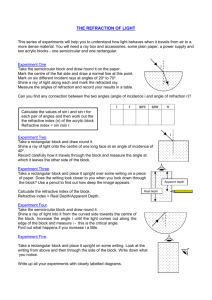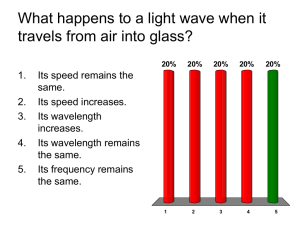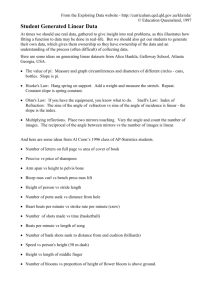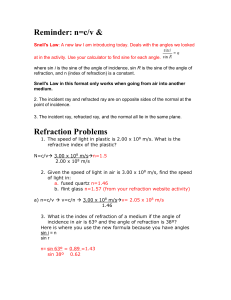2204-Unit4 – Part2 Notes
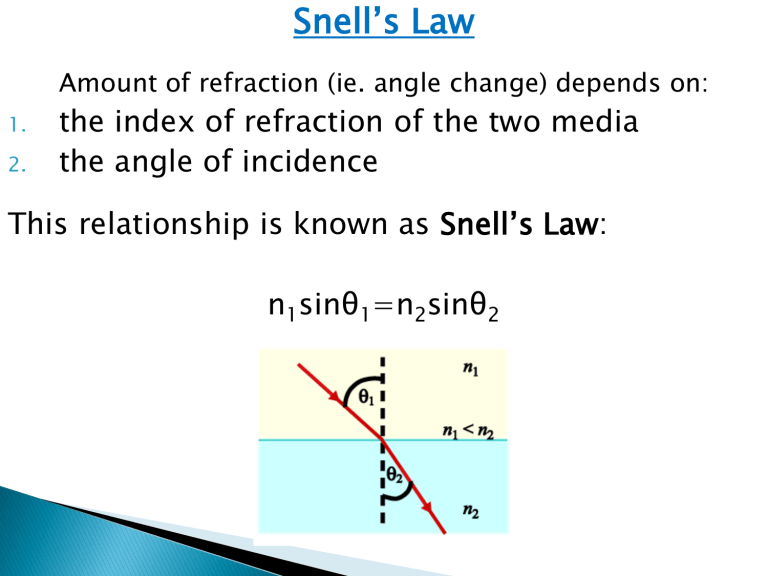
Snell’s Law
1.
2.
Amount of refraction (ie. angle change) depends on: the index of refraction of the two media the angle of incidence
This relationship is known as Snell’s Law: n
1 sinθ
1
=n
2 sinθ
2
i n i n r
n
1
sinθ
1
=n
2
sinθ
2
r where θ
1 n
1 n
2
θ
2
= the angle of incidence
= the angle of refraction
= index of refraction for incident medium
= index of refraction for refracting medium
Example 1:
A ray of light passes from air ( n=1.00) to water
(n =1.33), with an angle of incidence of 30 ° .
What is the angle of refraction?
n a x sin 30 0 = n w x sin Ɵ w
1.00 x ( 0.5) = 1.33 x sin Ɵ w
0.5 = sin Ɵ w
1.33
sin Ɵ w
= 0.3759
Ɵ w
= sin -1 ( 0.3759)
Ɵ w
= 22 0
Example 2:
Calculate the index of refraction for an incident substance where the angle of incidence is 30 ° , the angle of refraction is 50.0
° , and the index of refraction of the second substance is 1.50.
( n
1
= 2.3 )
Review – don’t write out. Lets do together.
1. When light passes from a more optically dense medium into a less optically dense medium, it will bend _______
(towards, away from) the normal.
2. When light passes from a medium with a high index of refraction value into a medium with a low index of refraction value , it will bend _______ (towards, away from) the normal.
** The higher the value of n the more optically dense the medium is, therefore the slower the light moves.....causing the light ray to move towards the normal when going from a high n value to a low one and away from the normal when going from a low n value to a higher one.
3. In each diagram, draw the "missing" ray (either incident or refracted) in order to appropriately show that the direction of bending is towards or away from the normal.
4. Arthur’s method of fishing involves spearing the fish while standing on the shore. The actual location of the fish is shown in the diagram below. Because of the refraction of light, the observed location of the fish is different than its actual location. Where does the fish appear to be? Must Arthur aim above or below where the fish appears to be in order to strike the fish?
5. A ray of light in air is approaching the boundary with a layer of crown glass at an angle of 42.0 degrees. Determine the angle of refraction of the light ray upon entering the crown glass and upon leaving the crown glass.
1 sin 42 = n
2 sin Θ
2
= 1 sin Θ
3
Θ
3
= 42
Practice: P.438 #’s 64, 66, 69, 60
a) b) c)
Θ
1
Θ
1
Θ
1
= 45 o
= 48 o
= 49 o
Comment on what is happening to the refracted light ray.
Critical Angle n r n i c
The
critical angle
for a particular material is the angle of incidence for which the angle of refraction is 90 o .
The symbol for critical angle is Θ c
.
In order for a critical angle to exist a material must
always be
material. ie. n
1 optically denser than the 2
> n
2 nd
From Snell , n
1 sin
c
= n
2 sin 90
Since sin 90 = 1, we have n
1 sin
c
= n
2 and the critical angle is
c
= sin -1 n
2 n i
Example:
What is the critical angle of a block of crystal glass (n = 1.54) sitting in air (n = 1).
Don't forget, material 1 is the glass.
Answer: 40.5
o
What is the point of knowing this?..........
Some very useful inventions have resulted by taking advantage of total internal reflection....
1. Periscope (tanks, submarines,...)
2. Binoculars
◦ uses a class prism to reflect light to prevent loss of light (pg.417)
3. Endoscopes (medical camera)
◦ allows doctor to explore a patient internally without unnecessary surgery. (pg. 417)
4. Bike reflectors (pg.417)
Assign: P.439 # 79, 80.
If you were to shine a laser (light of one color) at a barrier with a tiny slit (opening), what would you see on the screen?
A) a single line of light
B) a central light that gradually gets dimmer as you move out
C) an alternating series of bright and dark lines that gradually gets dimmer as you move out
Answer: C)
The pattern’s size and location varies with the width of the slit.
When light passes through a single opening that is close in size to it’s wavelength, the light waves interact forming a diffraction pattern.
Light passes through a single opening of width w.
A central bright spot is created, at center.
An alternating dark then bright pattern develops on both sides.
We use a formula to locate dark spots n=1, 2, 3, 4, 5 ...
We could locate bright spots at n=1.5, 2.5, 3.5...
Formula for minima, ie. dark spots n
w sin
n=nodal line # (minima/darkspot: n=1,2,3...) n
w sin
λ = wavelength of light (m) w= width of slit (m)
θ = angle away from center line
(degrees)
Example
A 20.0 µm slit is illuminated by a red light (620 nm). At what angle is the third order minimum located ?
w = 20.0 x 10 -6 m λ = 620 x 10 -9 m n = 3 nλ=wsinθ
θ = Sin -1 (nλ/w)
θ = Sin -1 (3 x 620 x 10 -9 / 20.0 x 10 -6 )
θ = 5.30
o
Assign p. 441 # 100 & 101.
Light’s Diffraction Pattern:
Wave, particle or something else ?
Watch
https://www.youtube.com/watch?v=Iuv6hY6 zsd0#t=403
Young’s Double Slit Experiment
When light passes through 2 small slits with a small separation (d) between slits they may create an interference pattern. For light, crests and troughs produce bright and dark spots on a screen.
nλ = dsinθ n n= order number (bright spot from center line)
λ = wavelength of light d= slit separation (distance between 2 slits)
θ n
= angle from center to n th maxima n
dx n
L n= order number
λ = wavelength of light d= slit separation (distance between 2 slits) x n
=distance from center to n th maxima
L = distance from centre of slits to maxima
Ex. 1:
A 450 nm light passes through two slits with separation of 3.00 µm. a) Find the angle at which the second order maximum is located on a screen 1.00 m from the slits.
n = 2 d = 3.00 x 10 -6 m
λ = 450 nm = 450 x 10 -9 m
θ
2
= ?
nλ = dsinθ n
θ
2
= sin-1 (n λ/d) = 17.5
o b) How far from the centre line is this second maximum located?
X = 0.300 m or 30.0 cm
** How would you find Minima (dark spots)? n = 0.5, 1.5, 2.5 ...
Practice p. 440 #92-94.
Speed – depends on medium.
Sound in Air – temperature, pressure, etc.
Speed of Sound in Air v sound
= 332m/s + 0.6 T
Note: T is temperature in o C
Waves in string – tension, string diameter/mass
Frequency – depends on source
Wave’s Frequency = Frequency of vibrating source
Wavelength (λ) – depends on Eq’n: λ = v/f
https://www.youtube.com/watch?v=imoxDcn
2Sgo
The frequency of a wave does not change once created. However, if the source and observer are moving relative to each other there is an apparent change in frequency, a
Doppler shift.
http://www.absorblearning.com/advancedphysics/ demo/units/040103.html#Introduction
Note:
Doppler effect involves apparent change in frequency observed due to relative velocity and not the change in loudness due to distance.
Doppler effect for sound: f
2
= v s f
1 v s
± v o
Where: f
2
= apparent frequency (Hz) f
1 v s v o
= original frequency of source (Hz)
= speed of sound (m/s)
= relative speed of observer (m/s)
+ when source/observer move apart
- when source/observer move towards each other
Ex.
It is 10.0 o C and you are moving toward a stationary alarm which has a frequency of
925 Hz. What is the apparent frequency you hear if you are traveling at 101 km/h ?
Answer ( 1010Hz )
Assign P. 480 # 64-66.
Water vapour condensed due to Sonic Boom.
If the source travels faster than the wave it will pass it’s own wave causing new waves to overlap the previous ones. This gives constructive interference at a V shape behind the object.
Shock wave behind boat moving > speed of water wave
An apparent shift in frequency can also occur with light waves. The difference in these frequencies tells us the speed of the object.
Main Applications:
Radar guns
Astronomy
Weather Radar
v r
Use the following for radar guns:
2 f f
1
c
Where f
2 f
1
f
f
2
f
1
is the measured frequency, is the emitted frequency v r
= relative velocity of object c = speed of light
Ex. A stationary police officer uses a radar gun emitting EM waves at 9.00 x 10 9 Hz. The detected waves differ by
2000 Hz. What is the speed of the approaching car?
v r
2 f f
1
c v r
2000
2 x 9 .
00 x 10
9
3 .
00 x 10
8
= 33 m/s
f
2
In astronomy the difference in colors (λ or f) is compared when a star or galaxy is moving. The change or shift in color tells us how fast it’s traveling.
Where:
f
1
1 v c f
2 f
1 is the observed frequency (Hz) is the source frequency (Hz) v = relative velocity of object c = speed of light (3.00x10
8 m/s)
Ex. Star ‘Swerc’ normally emits a frequency of 5.77x10
14 Hz.
On Earth we observe 5.76x10
14 Hz. What is the speed of the star and is it moving toward or away from us?
Lower f = moving away (use – sign) Answer: (520km/s)
In Example 1 the star is going away from the source.
This is called a red shift because the wavelength has shifted toward the red end of spectrum.
The opposite would be a blue shift.
Practice P. 440 # 83,84, 87



